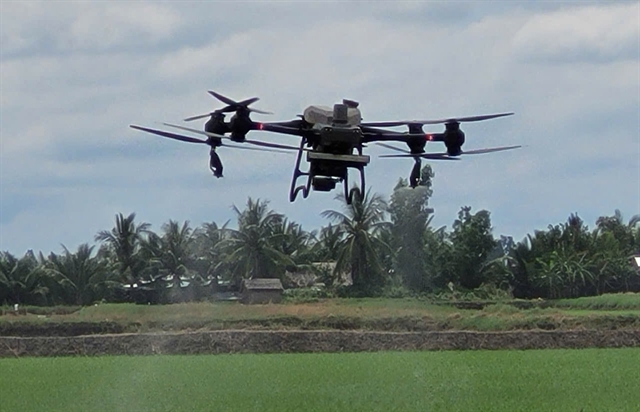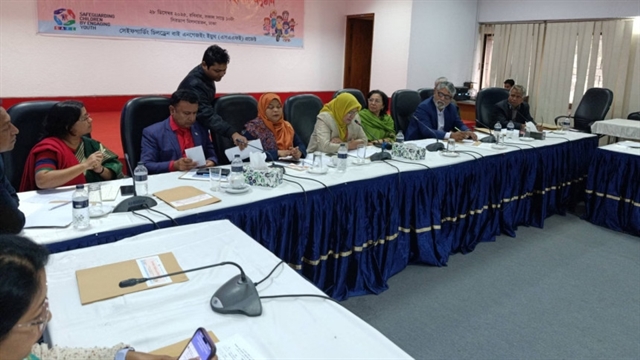 Society
Society

Việt Nam is experiencing a worrying spike in the use of amphetamine-type stimulants (ATS) and other types of synthetic drugs.
 |
| Authorities handle a amphetamine-type stimulants (ATS) user in Hà Nội. — Photo tiengchuong.vn |
HÀ NỘI – Việt Nam is experiencing a worrying spike in the use of amphetamine-type stimulants (ATS) and other types of synthetic drugs. Users suffer from a range of mentally destablising conditions - psychoses, hallucinations, extreme paranoia - leading to dangerous uncontrolled behaviour and posing high risks to themselves and society.
This was reported on Tiếng Chuông (Sound of the Bell), the website of the National Committee on AIDS, Drugs, and Prostitution Prevention and Control.
According to the Ministry of Public Security (MPS), in 2016 law enforcement authorities confiscated 840kg and 427,660 pills of crystal meth. By the end of last year, there were some 271,751 addicts across the country, the majority – upwards of 60 per cent – ATS users.
Largely responsible for this hike in meth use is a dramatic increase in its use among young people, particularly by the age group between 20 and 30, the report said.
Methamphetamine and amphethamine induce a state of euphoria and results in excessive energy and unusual alertness. These effects are said to last noticeably longer than those induced by cocaine, hence its rising popularity. However, after these highs, the body craves this state again but it has built up a certain tolerance so users need a higher dose to experience the same effects. This vicious cycle leads to a crippling dependence on the drugs.
The constant overdrive state induced by the drugs will eventually weaken organ functions, easily leading to kidney or heart failure.
Withdrawal is a towering challenge, but generally psychological in nature. The user may feel intense, insatiable cravings, sometimes agitation, numb sensors, mood swings, even memory loss of various degrees, among other effects.
The media is full of stories about out-of-control meth users, ranging from public distrubances to more dangerous acts like climbing electrical poles, dancing on roofs, traffic accidents, and crimes like terrorising people and murders.
Less than three months into 2017, a number of serious cases occurred in which the perpetrators were under the influence of illegal stimulants.
One month ago, for example, Nguyễn Thanh Tuấn, 26, living in Mỹ Tho City of the southern province of Tiền Giang, destroyed rows of glass windows in his neighborhood. Tuấn then proceeded to strike a food stall and lay waste to chairs and tables in a coffee shop nearby. The knife-wielding man even injured a police officer who tried to stem his rampage. He was found to be high on meth.
Earlier in February, in the central coastal city of Nha Trang, Hồ Trung Kiên, 27, in a meth-induced state of mind, insisted that his wife and children had been kidnapped. He broke all the glass windows and doors of his home, then grabbed a knife to chase his mother and other relatives and neighbours who he believed to be behind the "kidnapping", demanding that they immediately release his wife and children.
During the Tết (Lunar New Year) holiday, an 80-year-old woman, Trương Thị Nhịnh, unfortunately did not survive a fatal head injury, which police said was likely caused by her 31-year-old grandchild, Phạm Văn Cường, who lived in the same house in Hải Phòng City, and was a frequent abuser of meth. A day after the incident, the police could not get a confession from Cường who was still not in his right mind.
At the end of January, Nguyễn Khánh Duy, 20, drove a motorbike in the southern province of Hậu Giang after using meth. He was under the impression that strangers were chasing him so he stopped his motorbike and attacked a group of young men hanging out on the roadside, resulting in one death.
There is no medicine-based treatment for meth addiction, posing further challenges for authorities and state management, the Tiếng Chuông reported.
Local governments were asked to step up their information dissemination efforts and design more campaigns to raise awareness of the effects of drugs use, especially of ATS.
One integral part of the campaign includes protocols and recommended actions to take in dealing with a meth addict or person under the influence of meth. Key targets of the campaign will be people in their 20s and 30s. Families are also encouraged to report the status of addicted relatives to facilitate management by authorities.
More frequent inspections of high-risks venues – bars, karaoke bars and hotels – should be put higher on the local governments’ agendas, the ministry ordered, in a bid to curb the trade and use of meth. Police must also work in close collaboration with procuracies and courts to accelerate legal proceedings in meth-related crimes.
Concerned agencies need to conduct frequent medical examinations of known addicts to monitor their addiction status and locate high-risk users. The Government will encourage families of high-risk users to send them to voluntary rehabilitation centres, or to keep them away from dangerous objects if they stay in their own houses.
Grass-roots vigilance and reporting are also deemed a viable measure, as are protection mechanisms for informers to ensure they don’t face retaliation. —VNS




